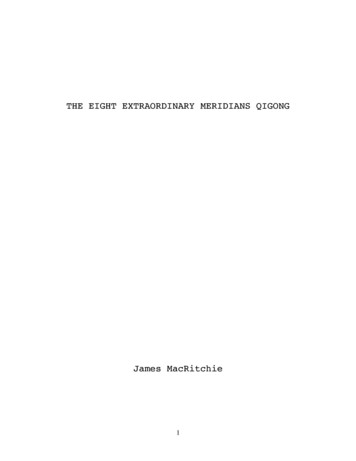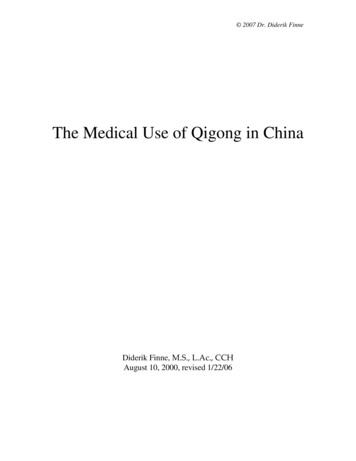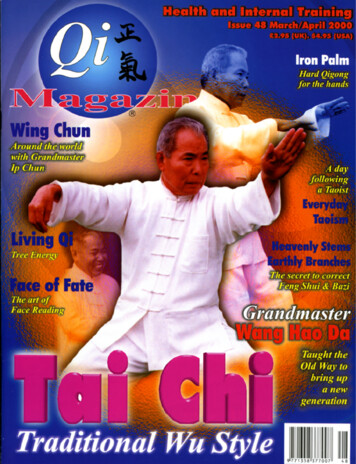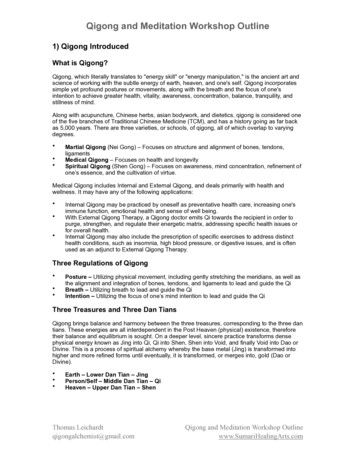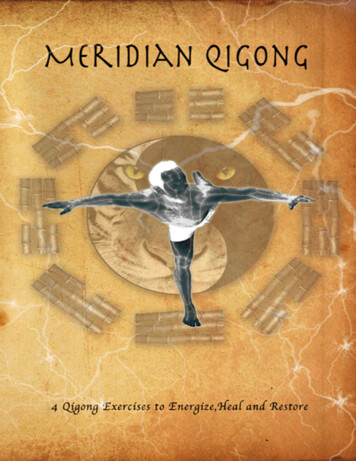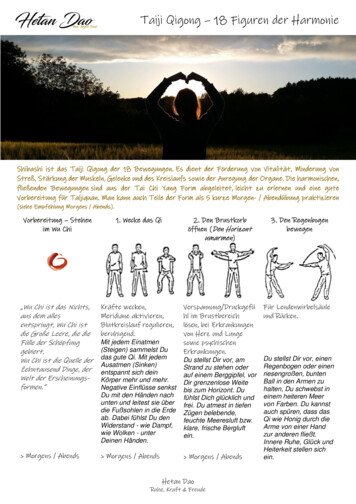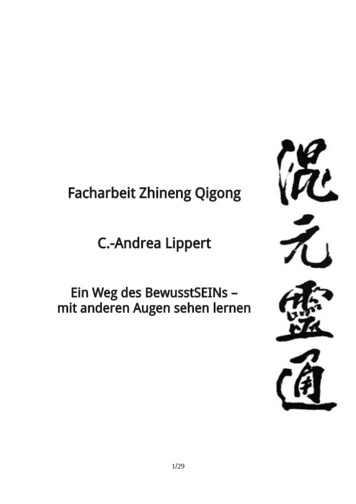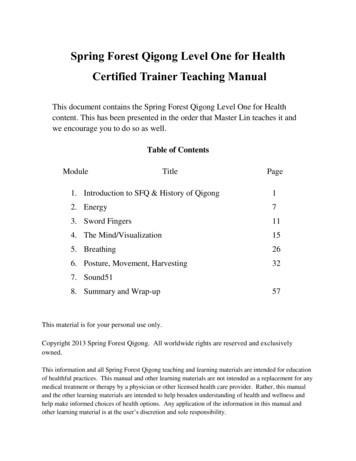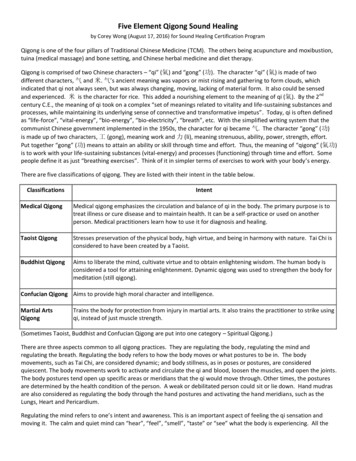
Transcription
Information-energy equivalence in qigong: reviewing Dossey and Schwartz’s “TherapeuticIntent/Healing Bibliography of Research” in light of Pang Ming’s Three Levels Theory of MatterbyOoi Kean Hin, Island Zhineng Qigong CentreSim Hann Liang, Usains Biomics Sdn BhdTan Soo Choon, Institute For The Research Of Molecular Medicine, Science University of MalaysiaABSTRACTThe paper “Therapeutic Intent/Healing Bibliography of Research”[1], together with relevant studies involvingthe effects of external qi healing found on the PubMed database from January 2000 to July 2012, werereviewed from the point of view of therapeutic intent mechanism and healing intent specificity. From anoriental medicine perspective, therapeutic intent is a form of external qi healing. Research into therapeuticintent has met significant resistance, primarily because there is no obvious theoretical model to account forthese phenomena. By applying the Three Levels Theory of Matter as proposed by Zhineng Qigong founder,Pang Ming, this article points the way to such a possible mechanism.KEYWORDSThree Levels Theory of Matter, therapeutic intent, nonlocal therapy, external qi therapy, external qi treatmentBACKGROUNDThere is both anecdotal and controlled experimental evidence that external qi healing/ prayer healing/therapeutic intent can be beneficial to patients diagnosed with a wide spectrum of diseases. A more recent, buthighly promising area of research, has involved the effects of mental intent on physically isolated, in vitrobiological tissues, as well as non-living targets, where statistically significant correlations with the pre-statedintend have been reported by labs throughout the world. While these phenomena have been widely replicated,discussed and statistically analyzed over the past century, little is understood about the mechanism responsiblefor them. A common question is “where does the energy come from?” This article discusses the mechanism ofnonlocal therapy in light of the Three Levels Theory of Matter as proposed by Zhineng Qigong founder, PangMing, with support from recent scientific findings.DISCUSSIONIntroduction to the Three Levels Theory of MatterIn Foundation of Zhineng Qigong Science – Hunyuan Holistic Theory (Hunyuan Zhengti Lilun) published in1994 [2], Pang Ming points out: “among physical mass, energy and information; information is the root ofeverything, it decides the transformation process of everything in the universe. Information is divided intosimple information and complex information, natural information and consciousness information.” It furtherpoints out: “consciousness information of human mental activity can cohere and accumulate into energy andmass (physical mass).” Between 1991 and 1998, thousands of studies were conducted under the direction ofthe Zhineng Qigong Center in China to validate this hypothesis. Many experiments were conducted by various1
universities and research centres, with the best theses compiled into Zhineng Qigong Scientific ResearchTheses - a series of 5 books published in October 1998. They are:a. Section I: Medical [3]- clinical papers describing the effects of external qi on more than 200 types ofdiseases; including randomised controlled trials (RCT) done at Foundation Medicine Research Center, ChinaMedical Science College, Jiangxi Medical College, Xingcheng Medical Center etc.b. Section II: Agriculture [4] – collection of reports on studies done between 1991 and 1997. Includingcomparative studies done by Guangxi Agriculture University, Anhui Agriculture Research Centre, HenanAgriculture Research Centre etc. The reports indicated successes in improving harvest and yield of crops fromrice to cotton, all with the help of external qi.c. Section III: Industrial [5] – a collection of studies on the application of external qi in industrial areas,including a study done by Haerbin Engineering University in improving the hardness of low carbon steel.d. Section IV: Education [6] – a collection of reports on how schools that introduced Zhineng Qigong as aform of exercise for teachers and students witnessed marked improvement in academic performance andbodily health.e. Section V: Helping The Poor [7]. An adult patient in a family means the productivity of the family could beaffected. The centre sent out teams of therapists to the villages to help the poor. This book is a collection ofaccounts describing how by practicing Zhineng Qigong and with the help of external qi therapy, patients(mainly farmers in remote areas) regain health and the family income rises.On June 24th, 1998, at a symposium titled “The New Phase in Zhineng Qigong Scientific Research - Validatingthe Foundation Theory” [8] Pang Ming renamed his hypothesis “Three Levels Theory of Matter” and urgedthe participants to put in more effort to validate this model. This is a new theory, proposing that there are threelevels of matter in the universe - a new perspective on the fundamental makeup and organization of reality.This hierarchy consists of: 1. physical matter, including both the atomic and the macroscopic level. This levelof matter exists in physical form, where the energy and information are embedded in the physical mass. 2. Thesecond level of matter includes the electromagnetic, gravitational and other fundamental forces. Here matterexists in the form of energy, where mass and information are embedded within the energy. These two levels ofmatter are well established by modern science. The third form is the level of matter manifesting asinformation. That implies that information can be converted to energy and mass. Although information doesnot exhibit the characteristics of energy, it can be transformed into various forms of energy and co-exists withthe two forms of matter above.Qigong views Qi as a form of information capable of effecting physical changes in specified targets during qitherapy and external qi treatment; and human consciousness (intention, thoughts) as capable of generating sucheffective information.Pang Ming subdivided qi into three groups:a. Primeval hunyuan qi, which is the most fundamental substrate of the universe; everything in the universeevolved from this.b. Hunyuan qi – the information content of all objects in the universe. Everything in the universe has its ownform of nonlocal, holistic information substructure.c. Yiyuanti - qi of the central nervous system of humans. This is the fundamental nature of humanconsciousness. In comparison to the two other levels of qi, it has initiative and selectivity. A person who learnsto stay mindful and focused (as taught in qigong training) has the ability to impose qi (or information) on thechosen targets, to bring about the desired outcome.2
EMPIRICAL SUPPORTI. Effects of Qi Information in Biological Experimentsa. Effects of external qi with opposing intentions on proliferation of Escherichia coli [9]In this study two experiments with the same design were carried out. In the initial experiment of both studies,the outcome value of the promoted group was significantly higher than that of the control (p 0.05), while thevalue of the inhibited group was significantly lower than that of the control group (p 0.01), suggesting thatthe healer's intent played a critical role in the effects of external qi on E.coli proliferation.b. Yan Xing Qigong external qi experiments on cancer cellsIn a study done in 2006, external qi of Yan Xin Qigong was found to differentially regulate the Akt andextracellular signal-regulated kinase pathways and was cytotoxic to cancer cells but not to normal cells [10].Another experiment conducted in 2008, revealed that external qi of Yan Xin Qigong induced G2/M arrest andapoptosis of androgen-independent prostate cancer cells by inhibiting Akt and NF-kappa B pathways. Incontrast, exposure to Yan Xin Qigong external qi increased phosphorylation of Akt and Erk1/2 in humanumbilical vein endothelial cells (HUVEC), and had no cytotoxic effect on either HUVEC or peripheral bloodmononuclear cells (PBMC) [11]. The third experiment done in 2010 induced apoptosis and inhibited migrationand invasion of estrogen-independent breast cancer cells through suppression of Akt/NF-kB signaling [12].The fourth experiment done in 2012 demonstrated that external qi of Yan Xin Qigong exerted potent cytotoxiceffect towards SCLC cell line NCI-H82 via induction of apoptosis [13].These findings suggest that external qi,the intent of a healer, may have specific anticancer effect. However no explanation on how external qi works isgiven in all 4 studies.c. Two studies on the effect of external qi therapy on cardiac autonomic tone [14-15]In the first study, heart-rate variability (HRV) was compared in 40 subjects receiving external Qi-therapy (QT)or placebo control therapy, in a randomized placebo controlled design experiment. The findings suggest thatexternal qi therapy stabilizes the sympathovagal function more than placebo therapy. In the second study HRVwas compared in 30 subjects receiving external qi therapy or placebo control therapy, in a crossover designexperiment. It was found that external qi therapy may act by stabilizing both the autonomic nervous systemand the emotional state.d. Effect of external qi on lymphoma growth in mice [16]This study examines the effectiveness of external qigong on the in vivo growth of transplantablemurine lymphoma cells in mice. The preliminary results suggest that qigong treatment might negativelyinfluence the growth of lymphoma cells.f. Effect of external qi on advanced cancer (single case study) [17]This study examines the effectiveness of external qi therapy in the management of advanced cancer symptomsin one patient. Although limited by the single case study approach, the results support similar literature reportson this topic and provide reasons to believe that external qi therapy might be beneficial.g. A case study of simultaneous recovery from multiple pathological conditions with medical qigongtherapy [18]The intensive qigong workshop in this study involved a patient’s training and practice for self-healing plusabout 10 sessions of external qi healing performed by a qigong healer for his pain and systematic adjustment.After the workshop and qigong therapy, the patient discontinued all medications (8 in total) and lost 35pounds; his blood pressure dropped from 220/110 with medication to 120/75 without medication (in 2 weeks);3
pulse rate dropped from 88 beats per minute resting to 68 beats per minute in the mornings and 55 bpm in theevening; the edema in his legs went away; symptoms of asthma and allergies disappeared; the PSA leveldropped from 11 to 4 (normal), all without any medications.h. Benefits of external qigong therapy on morphine-abstinent mice and rats [19].To effectively exclude possible psychological effects (placebo) of qigong therapy in the treatment of addiction,morphine-dependence models needed to be established in mice and rats.The effects of external qi on withdrawal syndrome were examined. The experiments showed that morphinedependent mice, after external qi therapy, had decreased incidence of jumping and lower jumping frequencies,and attenuated loss of body weight. After external qi therapy, morphine-dependent rats had reducedwithdrawal scores and body weight loss was inhibited. In the conditioned place preference test, the time spentin the drug-paired box was significantly shorter for the qigong group than for the morphine group. The resultssuggest that qigong might have an inhibitory effect on withdrawal syndrome, and reduce the dependencepotential in mice. Three different designs confirm that the impact of qigong therapy on morphine-abstinentmice and rats is reliable and substantial.Note that no explanation for how external qi works is given in any of the papers listed above.II. Double-Blind Test of the Effects of Distant Intention on Water Crystal Formation [20]In 2006, Radin D. and Emoto M. conducted a double-blind experiment to ascertain the hypothesis that the icecrystals formed by water can be affected by the information imposed onto that water sample. A group ofapproximately 2,000 people in Tokyo focused positive intention toward water samples located inside anelectromagnetically shielded room in California. The participants were unaware of similar water samples setaside in a different location as controls. Ice crystals formed from both sets of water samples were blindlyidentified and photographed, and the resulting images were blindly assessed for aesthetic appeal by 100independent judges. The results indicated that crystals from the qi treated water were given higher scores foraesthetic appeal than those from the control water (P .001, one-tailed). The study proved that humanconsciousness could remotely alter specific physical targets but not the control samples.III. ICRL ResearchIn the United States, scientists at the International Consciousness Research Laboratories [21] have beenstudying the effect of mental intent on the physical world by using a Random Event Generator (REG). TheREG is essentially an electronic coin flipper: if we flipped a coin 10 times, statistically we would get 5 headsand 5 tails. We would not be concerned if we got 6 heads or tails out of 10 flips. However, if we flipped it 10million times and got 6 million heads, then we would know that something is influencing the outcome. TheREG is a quantum mechanical device which is not affected by normal external physical forces. Its output isfundamentally random and impossible to predict [22]. The REG flips 200,000 times per second and when it isleft unattended will achieve statistically normal outcomes. However, when an operator “willed” the REG toperform either way, the output deviated to a statistically significant degree from the norm – which issomething that cannot be explained by current physics models [23]. ICRL has also explored the output ofREGs exposed to various group activities or environments. They named these FieldREG experiments, wherethe “field” was assumed to be a “consciousness information field”. This is similar to the description of “qifield” in Zhineng Qigong [24].In the book "Consciousness and the source of reality" [25] Jahn and Dunne stated that informal operatorreports alluded to a requisite sense of "resonance" between the operator and the device, task or purpose,whenever anomalous results were being achieved. This is commonly known among qigong practitioners as“qigong state” or meditative state whereby the operator/ practitioner formed a holistic entity with the device,4
task, or purpose. The unique brain wave pattern during qigong state (meditative state or highly mindful,focused state) has been reported by Richard Davidson of University of Wisconsin in the early 2000s [26] andin the study by Lagopoulos and colleagues in 2009 [27]. Combining this with the 'resonance' finding of ICRLwe can see that a rightly trained qigong practitioner who is able to remain mindful and focused is likely togenerate a much stronger result than untrained subjects.The ICRL researchers did not speculate about the possible mechanisms responsible for these results.According to the Three Level Theory of Matter, the information injected into the system by the operator wasconverted into the energy necessary to effect these observed changes.IV. External qi detected as infrared bioenergy [28]A study was done at the National Yang-Ming Medical College, Taiwan where electromagnetic pulses in the 3to 5 microns infrared spectrum were measured from the palm of a qigong master in the process of emittingexternal qi. The measurements were made using a III-V compound semiconductor InSb detector. It was foundthat the qigong master could emit two opposite kinds of qi, one with "facilitating" intent and the other one with"inhibiting" (destroying) intent. In the one with facilitating intent, large amounts of infrared radiation weredetected and the air temperature in the vicinity of the subject went up. When external qi with inhibiting intentwas emitted, the infrared wave was absorbed from the environment resulting in a cooling of the air.The biochemical effects of external qi from the same qigong master on the human fibroblast FS-4 wereinvestigated. The external qi with facilitating intent caused a 1.8% increase of the cell growth in 24 hrs, 1015% increase of DNA synthesis and 3-5% increase in protein synthesis of the cell in a 2-hr period; whileexternal qi with inhibiting intent caused 6% decrease of cell growth in a 24 hr period, 20-23% decrease ofDNA synthesis and 35-48% of protein synthesis in a 2-hr period. In addition, it was found that the respirationrate of boar sperm increased 12.5-13.0% after receiving 5 min exposure to external qi with facilitating intentand a decrease of 45-48% by exposure to 2-min of external qi with inhibiting intent. The results indicate thatthe external qi was capable of effecting bi-directional changes correlating with the intent of the qigong master.V. Micro-sculpture through the mind [29]In a study done in 1999, gold film of 100 100 square microns was laid on a semiconductor wafer to provethat human consciousness can accumulate energy to perform micro engraving through imagery thinking. Thestudy was carried out by a person with extraordinary ability and the images recorded under atomic forcemicroscope confirmed that the mind could perform micro-etching, such as generating holes, rings or pressurelines on the gold film. This result suggested that somehow conscious intent could generate sufficient energy toalter a gold film target.VI. Review of mind photography [30]Mind photography experiments were carried out in various ways in China back in the 1990s. Negativephotographic films of various forms were placed directly at Laogong (P 8), Yintang (Ex-HN 3), and Baihui(Du 20) acupuncture points on the body, or at a distance away from the experimenter. The films were shieldedwith black paper, black cloth bag, or kept in a metal box. Otherwise experiments were carried out in darkroom.It was found that the most important factor for success was the ability of the subject to remain mindful andfocused. While in deep meditative state (qigong state) the subject was able to control and regulate the external5
qi transmission and even write the designated characters assigned by the researcher. The study indicated thatthe intent of a qigong practitioner could create photon phenomena to expose shielded negative film.VII. Magnetic signals generated by external qi in a zero field lab [31]In this experiment done in 1991, 20 qigong practitioners emitted external qi toward the probe of a Gaussmeter through their Laogong point (middle of the palm) for a total of 32 times, while 6 non practitionersserved as controls. None of the 6 controls could produce any electromagnetic field stronger than 1nT whenthey simulated the work of the qigong practitioners. Three forms of electromagnetic fields were detected whenqigong practitioners emitted external qi to the probe. They were DC signal with flux density of 2 6x10nT, ACsignal with flux density of 2 2.6x10nT and pulse signal with flux density of 3 1.3x10nT. At the end of asession, when the practitioners had removed the palm away from the probe, most of the time (80%) the meterstill indicated a signal, suggesting that the field was still around. The field only dropped down to base levelwhen the qigong practitioners left the room.VIII. Physical Manifestation and Effects of External Qi [32]The half-life of a radioactive nucleus is determined by its intrinsic properties and is not affected by anyordinary physical conditions or chemical environments such as high temperature, high pressure, strongelectromagnetic fields, strong acids, or strong bases. To study whether external qi can affect the half-life of aradioactive isotope, two independent methods, namely the gamma-ray spectroscopy and the solid-state nucleartrack detector, were used to measure the gamma-rays and alpha particles, respectively, emitted during thedecay of radioactive isotope 241Am. Experiments were performed at the Institute of High Energy Physics, theChinese Academy of Sciences, with a total of 50 qi-emissions by Dr. Yan.Dr. Yan emitted and directed external qi onto the radioactive source from a remote location. The 241Amsource was placed on a table in the qi receiving room. Dr. Yan emitted external qi to the 241Am source from awide range of distances (3 m to 2,200 km). In one experiment the half-life of the radioactive isotope wasincreased by 9.5% or reduced by 11.3% (Table 9); in another experiment, it was increased by 6.7% or reducedby 12.0% (Table 11), again showing the bi-directional effect of external qi from Dr. Yan.IX. Information can be converted into energy: the landmark study of Sano et. al.“The fundamental law of thermodynamics implies that you can't get energy for nothing. Worse still, you willalways get out of a system less energy than you put in. But a nanoscale experiment inspired by a nineteenthcentury paradox that seemed to break those laws now shows that you can generate energy from information[33].” Nature Physics 6,988–9 (2010). Masaki Sano, Shoichi Toyabe and colleagues explored connectionsbetween statistical mechanics and information processing in order to study a much debated idea which seemsto violate the laws of thermodynamics. The Japanese researchers set up a very small version of a spiralstaircase and made a molecule climb up this staircase by applying information. The “staircase” was made ofpotential energy and created using electrical fields. A high-speed camera was used to photograph the molecule.Due to thermal energy the molecule would move in random motion (Brownian movement). When themolecule happened to move up the staircase, the researchers let it move freely; but when it happened to bemoving down the staircase, they blocked its motion by inserting an electrical field that acted as a virtual wall.Since the particle was moving to a location of higher potential it required energy to move up the staircase. Yetthe researchers did not input any energy to push the particle up – they simply used the information about whichdirection it happened to be moving in at any given time to guide the climb. The particle was made to climb upa spiral-staircase-like potential exerted by an electric field, gaining free energy larger than the amount of workdone on it (the energy needed to create the electric field wall included). This enabled Sato and colleagues to6
suggest a new fundamental principle of an ‘information-to-heat engine’ and the conclusion was drawn thatinformation could be converted into energy, causing the molecule to move up the staircase.SUMMARYIn the proposed Three Levels Theory of Matter, qi is a form of information, and information can be convertedinto energy. Human intention (external qi ) appears capable of generating energy at the site of remote targetsand bringing about bi-directional changes that correlate with the operator’s pre-stated intent. Given the farreaching implications of the results discussed in this paper, it is recommended that additional replications ofthese studies be conducted by independent labs, in conjunction with a theoretical framing of possible physicalmechanisms to account for target specificity, bi-directional effects and information/energy conversion.COMPETING INTERESTThe authors are qigong practitioners. However they have never met the founder of Zhineng Qigong, Pang Ming nor visited the ZhinengQigong Centres which operated from 1985 to 2000.AUTHOR INFORMATIONOKH is a qigong therapist and the National Industry Expert on Qigong Therapy appointed by the Malaysia Ministry of HumanResource. SHL is a researcher at Usains Biomics and TSC is the deputy director of the Institute For The Research Of MolecularMedicine and a lecturer at the School of Pharmaceutical Sciences, Science University of Malaysia. OKH carried out the literatureresearch and organization and drafted the manuscript. TSC and SHL participated in the review of the articles. All authors read andapproved the final manuscript.REFERENCES[1] Larry Dossey, Stephan A Swartz, Therapeutic Intent/Healing Bibliography of .pdf[2] Pang Ming, Hunyuan Zhengti Lilun, International Cultural Publication, ISBN 7-80105-163-7 (Chinese); 1994: 70-73[3] Huaxia Zhineng Qigong Center, Zhineng Qigong Research – Selected Theses 1 Medical Section, People Sport Publication, ISBN 75009-1686-8 (Chinese); 1998[4]Huaxia Zhineng Qigong Center, Zhineng Qigong Research – Selected Theses 2 Agriculture Section, People Sport Publication, ISBN7-5009-1688-4 (Chinese); 1998[5]Huaxia Zhineng Qigong Center, Zhineng Qigong Research – Selected Theses 3 Education Section, People Sport Publication, ISBN7-5009-1689-2 (Chinese); 1998[6]Huaxia Zhineng Qigong Center, Zhineng Qigong Research – Selected Theses 4 Agriculture Section, People Sport Publication, ISBN7-5009-1690-6 (Chinese); 1998[7]Huaxia Zhineng Qigong Center, Zhineng Qigong Research – Selected Theses 5 Helping The Poor Section, People Sport Publication,ISBN 7-5009-1691-4 (Chinese); 1998[8] Pang Ming, The New Phase in Zhineng Qigong Scientific Research - Validating The Foundation Theory, Zhineng Qigong Kexue,1998, 7th Issue. (in Chinese)[9] Linxiang Shao, M.S., Junping Zhang, M.S., Le Chen, B.S.,Xiaofeng Zhang, B.S., and Kevin W Chen, Ph.D., M.P.H.Effects of External Qi of Qigong with Opposing Intentions on Proliferation of Escherichia coli The Journal of Alternative andComplementary Medicine, Volume 15, Number 5, 2009, pp. 567–5717
http://www.ncbi.nlm.nih.gov/pubmed/19922249.[10] Yan X, Shen H, Jiang H, Zhang C, Hu D, Wang J, Wu X. External Qi of Yan Xin Qigong differentially regulates the Akt andextracellular signal-regulated kinase pathways and is cytotoxic to cancer cells but not to normal cells.Int J Biochem Cell Biol. 2006;38(12):2102-13. Epub 2006 Jun 27.[11] Yan X, Shen H, Jiang H, Zhang C, Hu D, Wang J, Wu X. External Qi of Yan Xin Qigong induces G2/M arrest and apoptosis ofandrogen-independent prostate cancer cells by inhibiting Akt and NF-kappa B pathways. Mol Cell Biochem. 2008 Mar;310(1-2):22734. Epub 2007 Dec 16.[12] Yan X, Shen H, Jiang H, Hu D, Zhang C, Wang J, Wu X. External Qi of Yan Xin Qigong Induces apoptosis and inhibitsmigration and invasion of estrogen-independent breast cancer cells through suppression of Akt/NF-kB signaling. Cell PhysiolBiochem. 2010;25(2-3):263-70. Epub 2010 Jan 12.[13] Yan X, Li F, Dozmorov I, Frank MB, Dao M, Centola M, Cao W, Hu D. External Qi of Yan Xin Qigong induces cell death andgene expression alterations promoting apoptosis and inhibiting proliferation, migration and glucose metabolism in small-cell lungcancer cells. Mol Cell Biochem. 2012 Apr;363(1-2):245-55. Epub 2011 Dec 10.[14] Lee MS, Kim MK, Lee YH. Effects of Qi-therapy (external Qigong) on cardiac autonomic tone: a randomized placebo controlledstudy. Int J Neurosci. 2005 Sep;115(9):1345-50.[15] Lee MS, Rim YH, Jeong DM, Kim MK, Joo MC, Shin SH. Nonlinear analysis of heart rate variability during Qi therapy(external Qigong) Am J Chin Med. 2005;33(4):579-88.[16] Chen KW, Shiflett SC, Ponzio NM, He B, Elliott DK, Keller SE. A preliminary study of the effect of external qigong on lymphomagrowth in mice.J Altern Complement Med. 2002 Oct;8(5):615-21.[17] Lee MS, Yang SH, Lee KK, Moon SR. Effects of Qi therapy (external Qigong) on symptoms of advanced cancer: a single casestudy. Eur J Cancer Care (Engl). 2005 Dec;14(5):457-62.[18] Chen KW, Turner FD. A case study of simultaneous recovery from multiple physical symptoms with medical qigong therapy.J Altern Complement Med. 2004 Feb;10(1):159-62.[19] Mo Z, Chen KW, Ou W, Li M. Benefits of external qigong therapy on morphine-abstinent mice and rats.J Altern Complement Med. 2003 Dec;9(6):827-35.[20] Radin D, Hayssen G, Emoto M, Kizu T. Double-blind test of the effects of distant intention on water crystal formation. Explore(NY). 2006 Sep-Oct;2(5):408-11.[21] International Consciousness Research Lab, http://icrl.org/basic-research/[22] Psyleron Consciousness Technologies and Research, http://www.psyleron.com/reg1 overview.aspx[23] Psyleron – Princeton Mind Matter Research, http://vimeo.com/4359545[24] Ooi Kean Hin, Creation of Qifield, in Zhineng Qigong – the science, theory and practice, CreateSpace, ISBN 978 145386700.2010: 376-389.[25] Robert Jahn, Brenda Dune, FieldREG: Randomness and Resonance, Consciousness and the source of reality, ICRL Press,Princeton, NJ. ISBN: 1-936-033-03-8, 2011: 105-115[26] Richard J Davidson, Well being and affective style: neural substrates and biobehavioural correlates, Philos Trans R Soc Lond BBiol Sci. 2004 September 29; 359(1449): 1395–1411. 1/[27] Lagopoulos J, Xu J, Rasmussen I, Vik A, Malhi GS, Eliassen CF, Arntsen IE, Saether JG, Hollup S, Holen A, DavangerS, Ellingsen Ø.Increased theta and alpha EEG activity during nondirective meditation. J Altern Complement Med. 2009Nov;15(11):1187-92.[28] Chien CH, Tsuei JJ, Lee SC, Huang YC, Wei YH. Effect of emitted bioenergy (external qi) on biochemical functions of cells.Am J Chin Med. 1991;19(3-4):285-92.[29] Si-Chen Lee, Chulin Sun, Jinchuan Shen, Yicheng Lin Micro-sculpture by psychokinesis Chinese Journal of Somatic Science(Chinese), 1999 Vol.9, No.4 :89-95 pture.pdf8
[30] JC Shen, CL Sun RS Mind Power Photography and External Chi Special Property Jan. 2008, Volume 4, Number 1: 53-68http://www.accordinstitute.org/2008 4 1 RS mind power photography.htm[31] Wu BJ, Xu JH, Liu JB, Wang XB, Jiao WC Study on magnetic signal by external qi in a zero field lab Chinese Journal ofSomatic Science (Chinese), 1991 Vol.1, No.5 :195-200[32] Yan Xin, Lu Zuyin, Zhang Tianbo, Wang Haidong, Zhu Rusheng Physical Manifestation and Effects of External Qi
Theses - a series of 5 books published in October 1998. They are: a. Section I: Medical [3]- clinical papers describing the effects of external qi on more than 200 types of . In 2006, Radin D. and Emoto M. conducted a double-blind experiment to ascertain the hypothesis that the ice crystals formed by water can be affected by the information .
